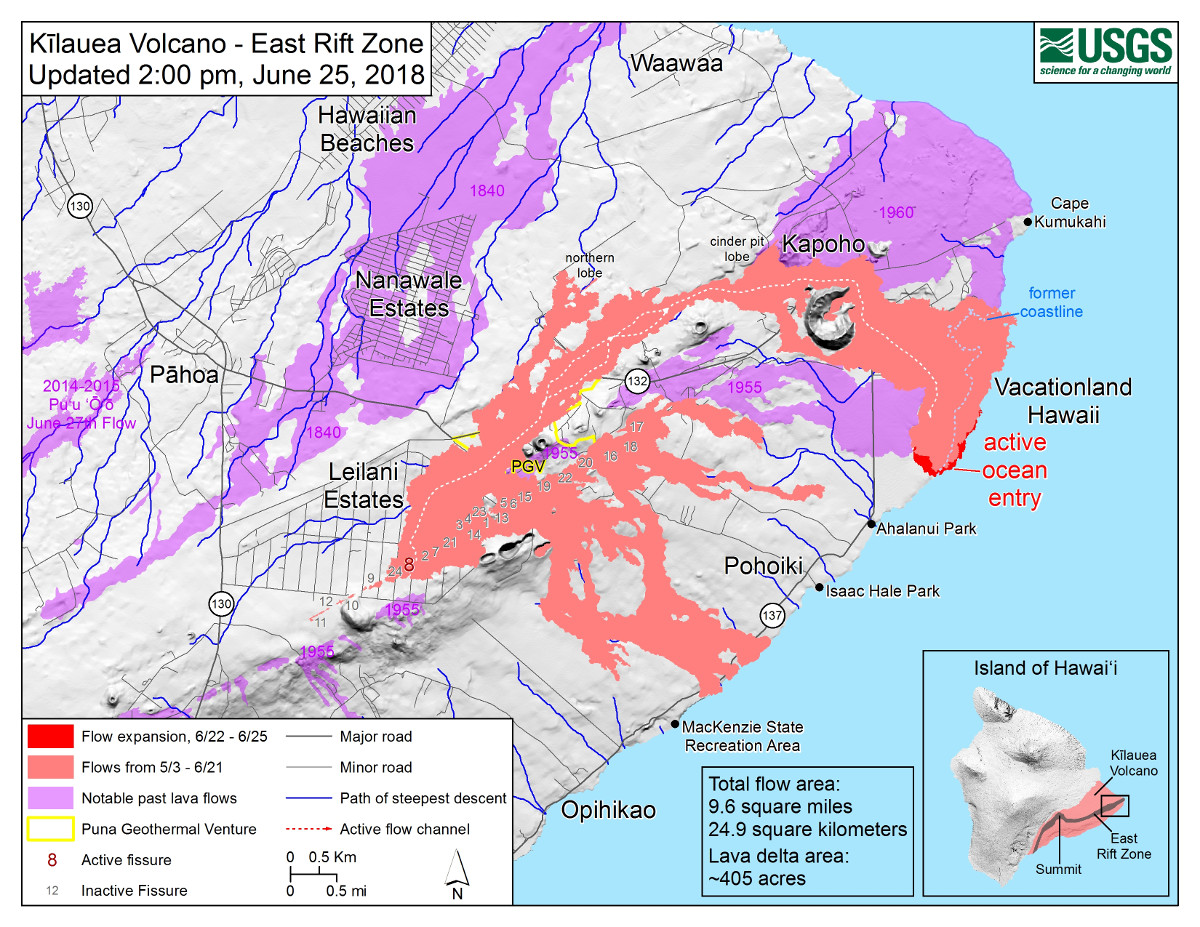
USGS: Map as of 2:00 p.m. HST, June 25, 2018. Given the dynamic nature of Kīlauea’s lower East Rift Zone eruption, with changing vent locations, fissures starting and stopping, and varying rates of lava effusion, map details shown here are accurate as of the date/time noted. Shaded purple areas indicate lava flows erupted in 1840, 1955, 1960, and 2014-2015
(BIVN) – Scientists continue to analyze the lava flow produced by Fissure 8 in Leilani Estates as it travels about 14 kilometers (or 8 and 1/2 miles) to the ocean.
Speaking to media during a Monday conference call, Mike Zoeller with the Center for the Study of Active Volcanoes at the University of Hawaii-Hilo said he recently witnessed lava moving in the open channel at a top speed of 25 kilometers per hour (or about 15.5 miles per hour), but noted that on Friday night, a colleague measured the lava in the channel flowing faster at 35 km/h.
Zoeller said there are no significant overflows of the lava channel at this time that are threatening any nearby communities. “So far all of those spill-overs have moved at a slow rate because they’re generally caused by small-scale failures at the top of the levees closest to the channel,” Zoeller explained.
Zoeller also said the lava delta at Kapoho “has been advancing southward at a slowing rate, which is now less than 50 meters per day. At about this time last week, it had been advancing southward at about 200 meters per day, but that rate has slowed.”
The closest lava is now just over one kilometer, or a little over half a mile, away from Ahalanui Beach Park, Zoeller said.
The USGS Hawaiian Volcano Observatory reported at 12:59 p.m. HST:
Fountains from Fissure 8 spatter cone continue to supply lava to the open channel with only small, short-lived overflows. The spatter cone is now 180 ft tall at its highest point, and fountains only occasionally rise above that point. The lava flow front at the coast broadened southward and is now nearly 2 miles in width. Lava is entering the sea this morning on the southern side of the flow front primarily through the open channel, but also along a 1-kilometer (0.6 mi) wide area marked by billowing laze plumes. Fissure 22 is weakly active and Fissure 16/18 was not observed this morning.
Pele’s hair and other lightweight volcanic glass fragments from the lava fountain at Fissure 8 continue to fall downwind of the fissure, dusting the ground within a few hundred meters (yards) of the vent. High winds may waft lighter particles to greater distances. Residents are urged to minimize exposure to these volcanic particles, which can cause skin and eye irritation similar to volcanic ash.

by Big Island Video News4:20 pm
on at
STORY SUMMARY
PUNA, Hawaii - The lava delta at Kapoho is advancing southward, and the closest lava is now just over half a mile away from Ahalanui Beach Park, officials said today.